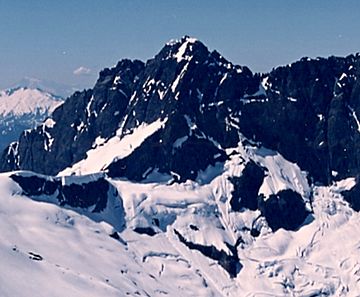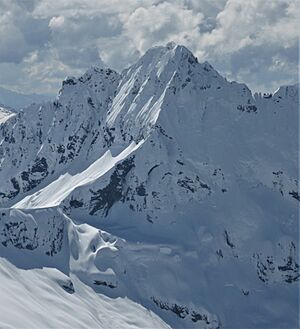Seahpo Peak facts for kids
Quick facts for kids Seahpo Peak |
|
|---|---|

Seahpo Peak
|
|
| Highest point | |
| Elevation | 7,313 ft (2,229 m) |
| Geography | |
| Location | Whatcom County, Washington, U.S. |
| Parent range | North Cascades |
| Topo map | USGS Mount Shuksan |
| Geology | |
| Age of rock | Cretaceous |
| Mountain type | Shuksan greenschist |
Seahpo Peak is a mountain peak located in Washington state, in the U.S.. It is a smaller peak next to the much larger Mount Shuksan. Seahpo Peak stands about 2 miles (3.2 km) east of Mount Shuksan's main peak. It reaches a height of about 7,441 feet (2,268 meters).
This mountain is found within the beautiful North Cascades National Park. It is also part of the larger North Cascades mountain range. Seahpo Peak is connected to Mount Shuksan by a high ridge called Jagged Ridge. This ridge is about 7,000 feet (2,134 meters) high.
Seahpo Peak is near the start of Sulphide Creek. This creek flows into the Baker River. You can see several waterfalls tumbling down the sides of Seahpo Peak. These include Seahpo Peak Falls and Cloudcap Falls. Sometimes, people even call the mountain Cloudcap Peak. The mountain is also on the south side of the Nooksack Cirque. This area is where the Nooksack River begins.
To the north of Seahpo Peak is the East Nooksack Glacier. There are also some smaller, unnamed glaciers to the south. Another ridge connects Seahpo Peak to Icy Peak. The name "Seahpo" comes from the French word chapeau, which means "hat."
How Mountains Formed
The North Cascades are known for their very rugged landscape. They have sharp, rocky peaks, long ridges, and deep valleys carved by glaciers. These amazing features were created over millions of years by geological events. These events caused huge changes in the land's height. This also led to different climates and types of plants in the area.
The Cascade Mountains started forming millions of years ago. This was during a time called the late Eocene Epoch. The North American Plate (a huge piece of Earth's crust) slowly moved over the Pacific Plate. This movement caused many volcanic eruptions.
Also, small pieces of the Earth's crust, called terranes, came together. This helped create the North Cascades about 50 million years ago.
Later, during the Pleistocene period (over two million years ago), glaciers played a big role. Huge sheets of ice moved forward and backward many times. They scraped and shaped the land, leaving behind rocks and debris. The "U"-shaped valleys you see today were formed by these glaciers. The combination of land pushing up (called uplift) and cracks in the Earth (called faulting) with glaciation has made the tall peaks and deep valleys of the North Cascades.
Weather at Seahpo Peak
Seahpo Peak is in a climate zone called the marine west coast climate. This type of climate is found in western North America. Most of the weather systems start over the Pacific Ocean. They then travel northeast towards the Cascade Mountains.
As these weather systems reach the North Cascades, the tall peaks force the air upwards. This causes the air to cool and drop its moisture. This means a lot of rain or snowfall falls on the Cascades. The western side of the North Cascades gets a lot of precipitation, especially snow in winter.
During winter, it's often cloudy. But in summer, high-pressure systems over the Pacific Ocean become stronger. This often leads to clear skies with little or no clouds. Because of the ocean's influence, the snow tends to be wet and heavy. This can create a high danger of avalanches.


